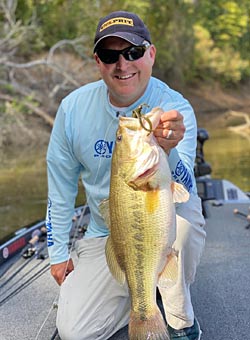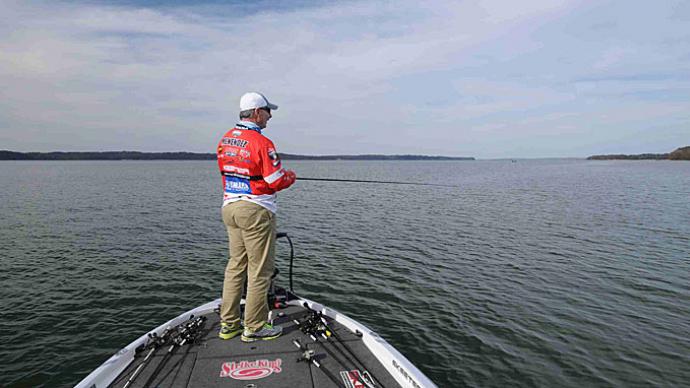
Mention North Carolina’s Shearon Harris Reservoir to Dustin Wilks, and he immediately recalls a memorable fishing trip. He was about 16 years old, his time on the Bassmaster Elite Series and qualifying for six Bassmaster Classic still in front of him. And on that frigid winter day, he caught a trio of bass that each pulled his handheld scale to 9 pounds and 15 ounces.
But another angler fishing that day saw Wilks’ bass, and he believed they weighed much more. So, when Wilks returned home, he put an item he knew weighed 15 pounds on his scale, and it again read 9 pounds and 15 ounces. And that’s how it goes at Shearon Harris, which is about 20 miles southwest of Raleigh, the state capital. You’ll have a great shot at numbers of big bass, but you’ll have to fish it to find out how big of one you can catch.
Shearon Harris, which covers 4,151 acres in the upper Cape Fear River basin, is a source of cooling water for a nearby nuclear power plant. But thanks to abundant structure and cover, it’s a trophy bass fishery, too. That reputation is well documented. Bassmaster magazine, for example, ranked it 13th on its list of the Southeast’s best bass lakes in 2019. And in March 2017, it produced five-bass limits of nearly 42 and 47 pounds in tournaments held on consecutive weekends.
Shearon Harris and nearby Jordan and Falls lakes received plenty of praise from competitors on Major League Fishing’s Bass Pro Tour, which fished all three lakes in March 2019. In that final round, Virginia angler Jacob Powroznik weighed 20 Shearon Harris bass for 63 pounds and 4 ounces — better than a 3-pound average — to win the $100,000 top prize.
The exposure has turned Shearon Harris into a popular fishing destination. “The fishing is still good if you don’t mind fishing around other people,” said Wilks, who resides in nearby Rocky Mount and hosts a television fishing show — Catching Bass with Dustin Wilks — on the Sportsman Channel. “All Raleigh lakes are like that,” he said. But Shearon Harris, he said, offers your best shot at a bass that weighs in the teens.
Count Bill Manning as one more fan of Shearon Harris. He grew up near Georgia’s Lake Lanier and lived close to Lake Hartwell in South Carolina before moving to Apex, North Carolina, in the early 1990s. “I started fishing Jordan, Shearon Harris, and Falls right away,” he said. He operates a guide service on Shearon Harris. “There is a lot of fish in it,” he said. “And there’s a lot of big fish in it.”

According to the state Wildlife Resources Commission sampling, catch rates at Shearon Harris are above average for North Carolina’s Piedmont reservoirs. “My average trip is 20 to 25 bass with probably two or three over 5 pounds,” Manning said. “But I’ve had trips when I’ve had half a dozen over 7 pounds.” He points to the lake’s state-mandated slot limit, which protects bass measuring 16 to 20 inches for producing bigger bass. He caught his largest — 11.97 pounds — during a tournament, and about 25% of his clients go home with pictures of one weighing 8 pounds or more.
An abundance of structure and cover support Shearon Harris’ world-class fishing. Its shorelines are undeveloped, so most of the lake is ringed with emergent aquatic vegetation, including reeds and pads, a rarity in this part of the country. In recent years, it has had extensive beds of submerged hydrilla targeted for removal. But plenty of other off-shore structure options remain. Wilks said the lake is a stable system, seeing minimal effects from high and low water compared to nearby waters.
Manning said the size and number of bass you catch and how you catch them depends on when you fish Shearon Harris. His favorite season for big bass is spring, when most of the lake’s big prespawn females are in less than 5 feet of water, enjoying the warming temperature. He looks to the trees to get an idea of the water temperature, which guides his presentation choice. He said that redbuds are the first to show, which coincides with about 60-degree water. When he sees Bradford pears’ white flowers, the water has warmed to between 63 and 65 degrees. “And when the dogwoods bloom, [the bass] are going to be on the bank,” he said.
Water temperature from the 60s to low 70s, found from spring through early summer, draws most Shearon Harris bass into the lake's hundreds of pockets along its four primary arms and within easy reach of most anglers. Manning said the spawn happens over about four weeks, while there are always prespawn and postspawn bass to chase.

Wilks starts his springtime fishing with moving baits, specifically jerkbaits and swimbaits. They cover water quickly, allowing him to efficiently find prespawn bass, which congregate near spawning flats. Once the water temperature reaches 60 degrees, he follows the bass onto spawning flats, pitching Texas-rigged lizards and casting frogs to visible cover and other likely spawning spots. Powroznik targeted these with a wacky-rigged worm.
Once summer is in full swing, bass head offshore. While Shearon Harris’ submerged hydrilla beds may be gone, bass have plenty of other options. “There are tons of really defined channels,” said Wilks, who prefers to fish on rainy days or after a cold front to miss the crowds. Some submerged cedar trees are standing, which will hold bass when conditions are right. In other reservoirs, those options have either silted in or tumbled over. He likes to grind deep-diving crankbaits over each piece of structure’s “sweet spot,” where a piece of isolated cover, for example, will anchor a school of bass. He also hops big flutter spoons and drags Carolina rigs across them. He keeps a topwater rigged to take advantage of schooling bass, a common summertime occurrence on the lake.
Manning said large schools of Shearon Harris bass, many weighing between 3 and 4 pounds, can be found offshore throughout June and July. It’s the best time to catch numbers — “As fast as you can reel them in,” he said. “It’s a fantastic offshore lake because most people beat the bank. They don’t know how to fish the ledges.” He’s working to change that. Most of his clients are tournament anglers preparing for an upcoming event or a new anglers wanting hands-on lessons, including fishing offshore structure.
Some of Shearon Harris’ bass return to shallow water in fall, especially after the remnants of a hurricane. Rain raises the lake’s level just enough to invite bass back into shoreline vegetation. Go after them with a spinnerbait, vibrating jig, or your favorite flipping lure. And there’s still a chance to catch bass that are schooling offshore.
Fishing pressure is the lightest during winter. And with little to no hydrilla, Manning said bass spend this season offshore. There they chase massive schools of threadfin shad, he said, so bring lures that imitate baitfish. Wilks suggests heavy spinnerbaits and umbrella rigs. And like during summer, Manning said electronics are vital for finding them.
Planning your trip to Shearon Harris Reservoir, which is in Wake and Chatham counties, will involve less searching. It’s a short ride from Raleigh-Durham International Airport and the intersection of interstates 95 and 40. Manning, who can be reached at 919-723-8569, said lodging, restaurants, and fuel are available nearby in Holly Springs, Apex, Sanford, and Fuquay-Varina. All are an easy commute to either of the lake’s launch ramps and if you want to extend your stay, Falls and Jordan lakes. Find more information at visitnc.com, visitraleigh.com, visitpittsboro.com, and welcometosanford.com.




